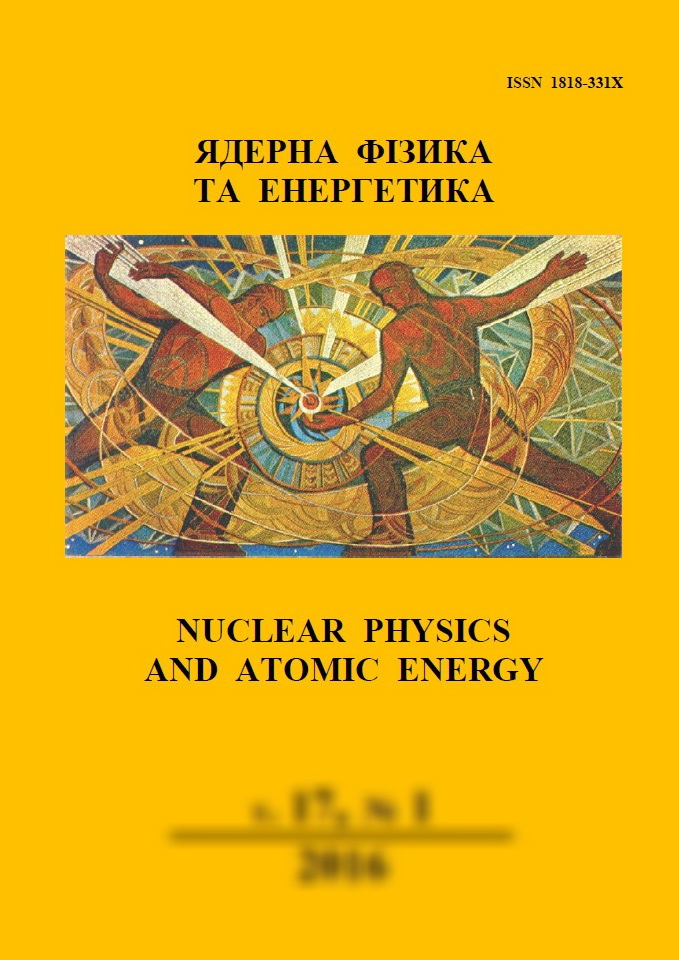 |
Ядерна фізика та енергетика
Nuclear Physics and Atomic Energy
ISSN:
1818-331X (Print), 2074-0565 (Online)
Publisher:
Institute for Nuclear Research of the National Academy of Sciences of Ukraine
Languages:
Ukrainian, English, Russian
Periodicity:
4 times per year
Open access peer reviewed journal
|
Nucl. Phys. At. Energy 2017, volume 18, issue 3, pages 267-275.
Section: Atomic Energy.
Received: 15.06.2017; Accepted: 12.10.2017; Published online: 28.12.2017.
 Full text (ua)
Full text (ua)
https://doi.org/10.15407/jnpae2017.03.267
Monte Carlo code Serpent calculation of the parameters of the stationary nuclear fission wave
V. M. Khotyayintsev1,*, V. I. Gulik2, O. M. Khotyayintseva3, A. V. Aksonov1, V. M. Pavlovych3
1 National Taras Shevchenko University, Kyiv, Ukraine
2 Institute for Nuclear Safety Problems, National Academy of Sciences of Ukraine, Kyiv, Ukraine
3 Institute for Nuclear Research, National Academy of Sciences of Ukraine, Kyiv, Ukraine
*Corresponding author. E-mail address:
vkhot@univ.kiev.ua
Abstract:
In this work, propagation of the stationary nuclear fission wave was simulated for series of fixed power values using Monte Carlo code Serpent. The wave moved in the axial direction in 5 m long cylindrical core of fast reactor with pure 238U raw fuel. Stationary wave mode arises some period later after the wave ignition and lasts sufficiently long to determine kef with high enough accuracy. The velocity characteristic of the reactor was determined as the dependence of the wave velocity on the neutron multiplication factor. As we have recently shown within a one-group diffusion description, the velocity characteristic is two-valued due to the effect of concentration mechanisms, while thermal feedback affects it only quantitatively. The shape and parameters of the velocity characteristic critically affect feasibility of the reactor design since stationary wave solutions of the lower branch are unstable and do not correspond to any real waves in self-regulated reactor, like CANDLE. In this work calculations were performed without taking into account thermal feedback. They confirm that theoretical dependence correctly describes the shape of the velocity characteristic calculated using the results of the Serpent modeling.
Keywords:
nuclear fission wave, breed-and-burn reactor, traveling wave reactor, CANDLE, Serpent.
References:
1. H. Sekimoto, K. Ryu, Y. Yoshimura. CANDLE: The New Burnup Strategy. Nuclear Science and Engineering 139 (2001) 306.
https://doi.org/10.13182/NSE01-01
2. H. Sekimoto, N. Nakayama. Power level control of CANDLE reactor without control rods. Annals of Nuclear Energy 63 (2014) 427.
https://doi.org/10.1016/j.anucene.2013.08.022
3. P. Hejzlar et. al. Traveling Wave Reactor Development Program Overview. Nuclear Engineering and Technology 45(6) (2013) 731.
https://doi.org/10.5516/NET.02.2013.520
4. J. Gilleland, R. Petroski, K. Weaver. The Traveling Wave Reactor: Design and Development. Engineering 2 (2016) 88.
https://doi.org/10.1016/J.ENG.2016.01.024
5. M. Zheng et. al. Study of Traveling Wave Reactor (TWR) and CANDLE Strategy: A Review Work. Progress in Nuclear Energy 71 (2014) 195.
https://doi.org/10.1016/j.pnucene.2013.12.010
6. L.P. Feoktistov. The neutron-fission wave. Doklady Akademii Nauk SSSR 309 (1989) 864. (Rus)
7. V. M. Pavlovich, V. M. Khotyayintsev, O. M. Khotyayintseva. Nuclear burning wave reactor: wave parameter control. Yaderna Fizyka ta Energetyka (Nucl. Phys. At. Energy) 11(1) (2010) 49. (Ukr)
https://jnpae.kinr.kyiv.ua/11.1/Articles_PDF/jnpae-2010-11-0049-Pavlovich.pdf
8. D. Hartanto, Y.H. Kim. A compact breed and burn fast reactor using spent nuclear fuel blanket. PHYSOR 2012 – Advances in Reactor Physics – Linking Research, Industry, and Education (Knoxville, Tennessee, USA, April 15 - 20, 2012). CD-ROM, American Nuclear Society, LaGrange Park, IL (2012).
Article
9. H. Van Dam. Self-stabilizing criticality waves. Annals of Nuclear Energy 27 (2000) 1505.
https://doi.org/10.1016/S0306-4549(00)00035-9
10. X.-N. Chen, W. Maschek. Transverse buckling effects on solitary burn-up waves. Annals of Nuclear Energy 32 (2005) 1377.
https://doi.org/10.1016/j.anucene.2005.01.012
11. S. Fomin et al. Initiation and propagation of nuclear burning wave in fast reactor. Progress in Nuclear Energy 50 (2008) 163.
https://doi.org/10.1016/j.pnucene.2007.10.020
12. B. Gaveau et al. Hybrid soliton nuclear reactors: A model and simulation (encapsulated long living accelerator driven system). Nuclear Engineering and Design 235 (2005) 1665.
https://doi.org/10.1016/j.nucengdes.2005.02.001
13. A.G. Osborne, M.R. Deinert. Comparison of neutron diffusion and Monte Carlo simulations of a fission wave. Annals of Nuclear Energy 62 (2013) 269.
https://doi.org/10.1016/j.anucene.2013.06.023
14. R. Shrestha, Rizwan Uddin. Modeling space–time evolution of flux in a traveling wave reactor. Annals of Nuclear Energy 70 (2014) 90.
https://doi.org/10.1016/j.anucene.2014.03.011
15. S. Qvist. Safety and Core Design of Large Liquid-Metal Cooled Fast Breeder Reactors. Ph.D thesis (University of California, Berkeley, USA, 2013).
https://escholarship.org/content/qt64g748hn/qt64g748hn.pdf
16. V.M. Khotyayintsev, V.M. Pavlovych, О.M. Khotyayintsevа. Travelling-wave reactor: velocity formation mechanisms. In: PHYSOR 2010, on CD-ROM.
Google Books
17. O. M. Khotyayintseva, V. M. Khotyayintsev, V. M. Pavlovich. Temperature feedback effect to stationary wave of nuclear fusion. Yaderna Fizyka ta Energetyka (Nucl. Phys. At. Energy) 15(1) (2014) 26. (Rus)
https://jnpae.kinr.kyiv.ua/15.1/Articles_PDF/jnpae-2014-15-0026-Khotyayintseva.pdf
18. O. M. Khotyayintseva et al. Study of the stability of the stationary wave of nuclear fissions. Yaderna Fizyka ta Energetyka (Nucl. Phys. At. Energy) 15(3) (2014) 253. (Rus)
https://jnpae.kinr.kyiv.ua/15.3/Articles_PDF/jnpae-2014-15-0253-Khotyayintsev.pdf
19. V.M. Khotyayintsev et al. Velocity characteristic and stability of wave solutions for a CANDLE reactor with thermal feedback. Annals of Nuclear Energy 85 (2015) 337.
https://doi.org/10.1016/j.anucene.2015.04.044
20. O. M. Khotyayintseva, V. M. Khotyayintsev, V. M. Pavlovich. Reactivity in the theory of the stationary nuclear fission wave. Yaderna Fizyka ta Energetyka (Nucl. Phys. At. Energy) 17(2) (2016) 157. (Ukr)
https://jnpae.kinr.kyiv.ua/17.2/Articles_PDF/jnpae-2016-17-0157-Khotyayintseva.pdf
21. A.E. Walter, A.B. Reynolds. Fast Breeder Reactors (New York: Pergamon Press, 1981) 853 p.
Google Books
22. J. Leppaenen. SERPENT Monte Carlo reactor physics code. In: Proc. of the Twentieth Symposium of Atomic Energy Research (2010) p. 790.
https://inis.iaea.org/search/search.aspx?orig_q=RN:41131393
23. V. Gulik, V. Pavlovych, A.H. Tkaczyk. Using SERPENT Monte Carlo and Burnup code to model Traveling Wave Reactors (TWR). In: Proc. of Joint Intern. Conf. on Supercomputing in Nuclear Applications & Monte Carlo (SNA&MC2013) (Paris, France, 27 - 31 Oct. 2013) p. 01103.
https://doi.org/10.1051/snamc/201401103
